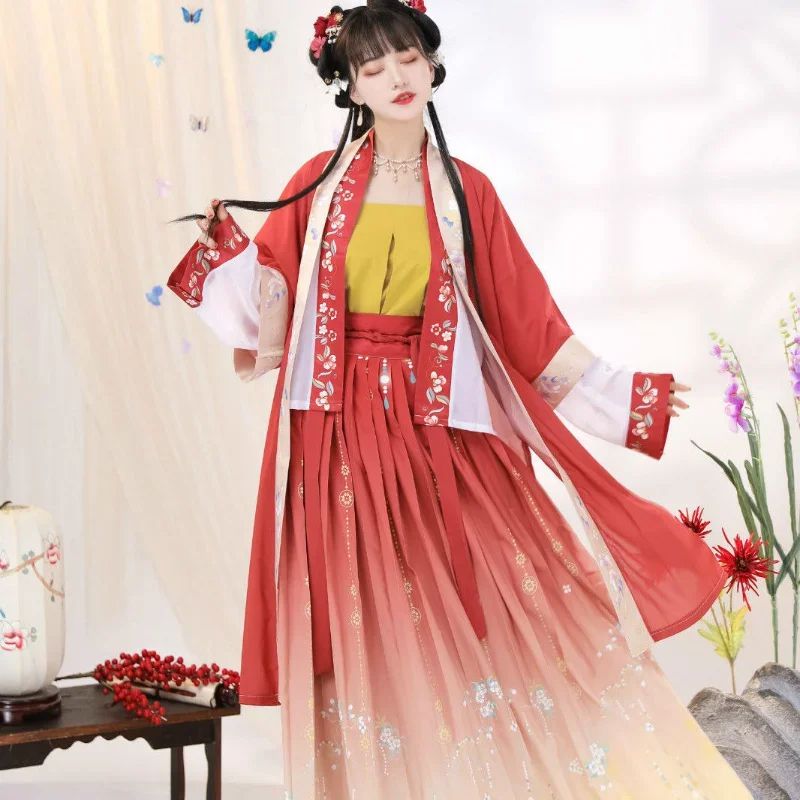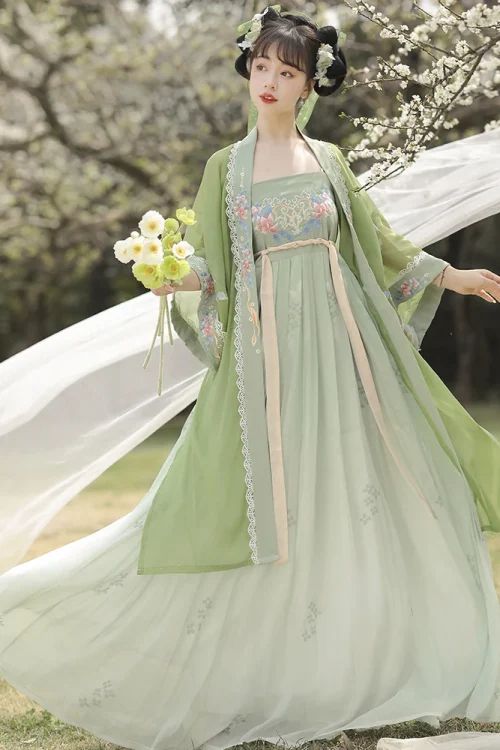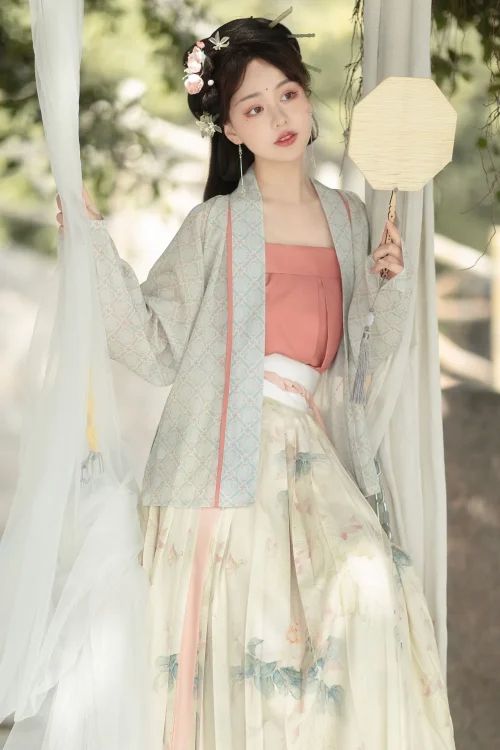The Exquisite Silk and Linen of Song Dynasty Hanfu
During the Song Dynasty (960-1279), Hanfu, the traditional Chinese attire, reached a pinnacle of elegance and refinement. The fabrics and techniques employed in its creation were instrumental in shaping its exquisite beauty.

The Role of Silk
Silk, a luxurious and versatile material, was the primary fabric used in Song Dynasty Hanfu. Its smooth texture, lustrous sheen, and exceptional drape made it ideal for creating flowing robes and graceful skirts. The production of silk in China had advanced significantly, with skilled artisans weaving intricate patterns and motifs into the fabric.
The Use of Linen
Linen, a durable and breathable fabric, was also widely used in Hanfu. Its natural fibers provided comfort, making it suitable for everyday wear. Linen garments were often adorned with embroidery or dyed in vibrant colors to enhance their aesthetic appeal.
Innovative Weaving Techniques
The Song Dynasty witnessed the development of innovative weaving techniques that further enhanced the beauty of Hanfu. One such technique was the use of “jin” (gold thread) to create intricate designs on silk fabrics. Jin, made from real gold or silver, added opulence and grandeur to Hanfu.
Another notable technique was “ke” (cutwork), which involved cutting out sections of fabric and replacing them with contrasting fabrics or embroidery. This technique added a delicate touch to Hanfu, creating visually stunning effects.
Functionality and Artistic Expression
The combination of exquisite fabrics and skilled craftsmanship resulted in Hanfu that was not only beautiful but also highly functional. The flowing robes and skirts allowed for freedom of movement, while the breathable fabrics provided comfort in all seasons. Hanfu also served as a canvas for artistic expression, with intricate patterns and motifs reflecting the cultural and aesthetic values of the Song Dynasty.
Conclusão
In conclusion, the Hanfu of the Song Dynasty was a testament to the exceptional craftsmanship and artistic sensibilities of the era. The use of luxurious fabrics such as silk and linen, combined with innovative weaving techniques, created vestuário that were both aesthetically pleasing and highly functional. Hanfu remains an enduring symbol of Chinese cultural heritage, showcasing the beauty and elegance of traditional Chinese attire.
Intricate Embroidery and Dyeing Techniques in Song Dynasty Hanfu
During the Song Dynasty (960-1279), Hanfu, the traditional Chinese attire, reached new heights of elegance and sophistication. The fabrics and techniques employed in its creation were instrumental in this transformation, showcasing the artistry and craftsmanship of the era.

The Primacy of Silk
Silk, a luxurious and versatile fabric, was the primary choice for Song Dynasty Hanfu. Its smooth texture and lustrous sheen lent an air of refinement to the garments. Silk was often woven into intricate patterns, such as brocade and damask, adding depth and texture to the fabric.
The Role of Cotton and Linen
Cotton, a more affordable and durable material, was also widely used. Its breathability and comfort made it suitable for everyday wear, often adorned with embroidery or dyeing techniques to enhance its aesthetic appeal. Linen, derived from flax fibers, provided a crisp texture and natural luster, often used for summer attire or as undergarments.
Remarkable Dyeing Techniques
The dyeing techniques employed in Song Dynasty Hanfu were equally remarkable. Natural dyes from plants, minerals, and insects created a vibrant and diverse palette. Indigo, extracted from the indigo plant, produced deep blue hues, while safflower yielded rich red colors.
Intricate Embroidery
Embroidery was another essential element of Song Dynasty Hanfu. Intricate designs were meticulously stitched onto the fabric using silk or cotton threads. The motifs often depicted auspicious symbols, such as dragons, phoenixes, and flowers. Techniques included satin stitch, chain stitch, and couching, each adding unique texture and dimension.
Conclusão
The combination of exquisite fabrics and intricate techniques resulted in Hanfu that was visually stunning and highly functional. The garments reflected the cultural and artistic sensibilities of the Song Dynasty, showcasing the ingenuity and creativity of its artisans. Today, Song Dynasty Hanfu continues to inspire contemporary fashion designers, serving as a testament to the enduring legacy of Chinese textile craftsmanship.
A evolução do Hanfu Fabrics and Techniques during the Song Dynasty
During the Song Dynasty (960-1279), the Hanfu, the traditional Chinese garment, underwent significant advancements in fabrics and techniques. This period witnessed a flourishing of the textile industry, leading to the development of new and innovative materials and production methods.

The Rise of Silk
One of the most notable developments was the widespread use of silk. Silk production, having been a major industry in China for centuries, reached new heights of refinement. Song Dynasty silk was renowned for its exceptional quality, with fine threads and a lustrous sheen, used to create a wide range of Hanfu garments.
The Popularity of Cotton
In addition to silk, cotton gained popularity during the Song Dynasty. Cotton was a more affordable and durable material, making it suitable for a broader range of garments. Commoners, laborers, and even soldiers often wore cotton Hanfu.
Advanced Dyeing Techniques
The Song Dynasty also saw the introduction of new dyeing techniques. While natural dyes derived from plants and minerals had previously been used, chemical dyes began to be employed, allowing for a wider range of colors and more vibrant hues.
Decorative Techniques
Embroidery became increasingly elaborate during this period, with intricate designs adorning Hanfu garments. Gold and silver threads were often used to create opulent and eye-catching embroidery.
Innovative Weaving Techniques
The Song Dynasty also witnessed the development of new weaving techniques, such as the invention of the drawloom. This innovation allowed for the creation of complex patterns and textures, resulting in unique and stylish Hanfu garments.
Conclusão
The advancements in fabrics and techniques during the Song Dynasty profoundly impacted Hanfu. Garments became more refined, elegant, and diverse, reflecting the cultural and economic prosperity of the era. Today, they continue to be admired as a testament to the ingenuity and artistry of Chinese textile artisans.
